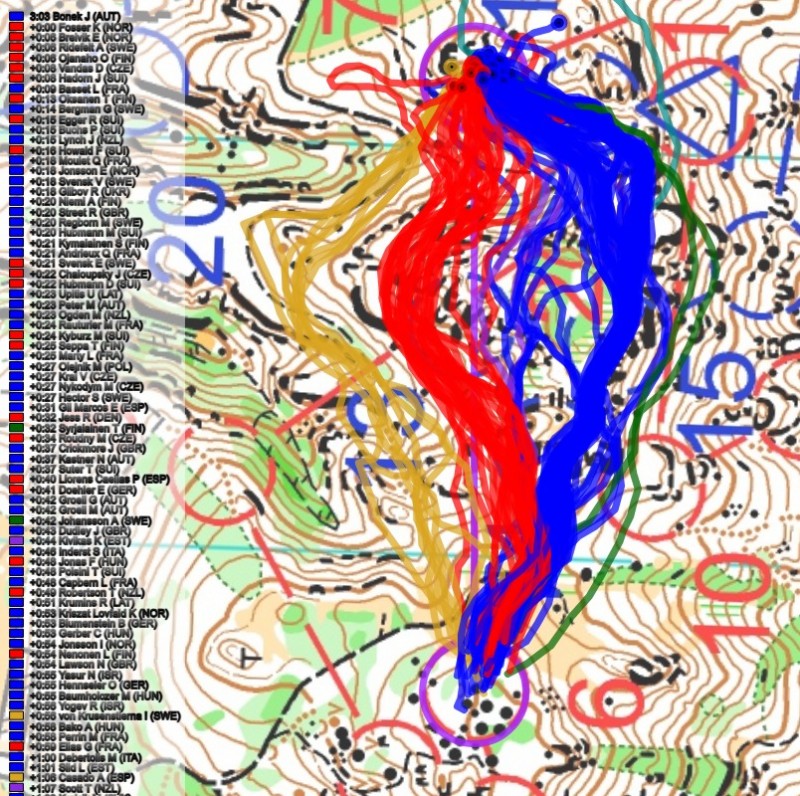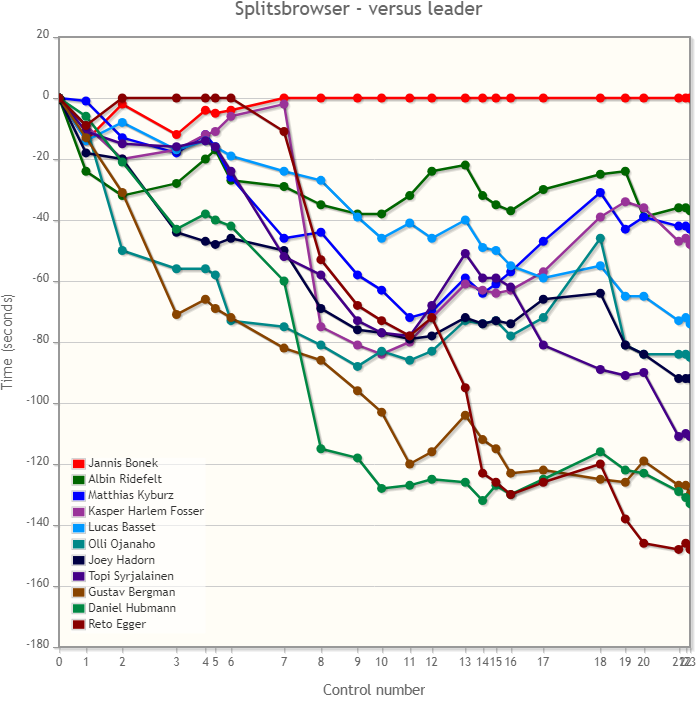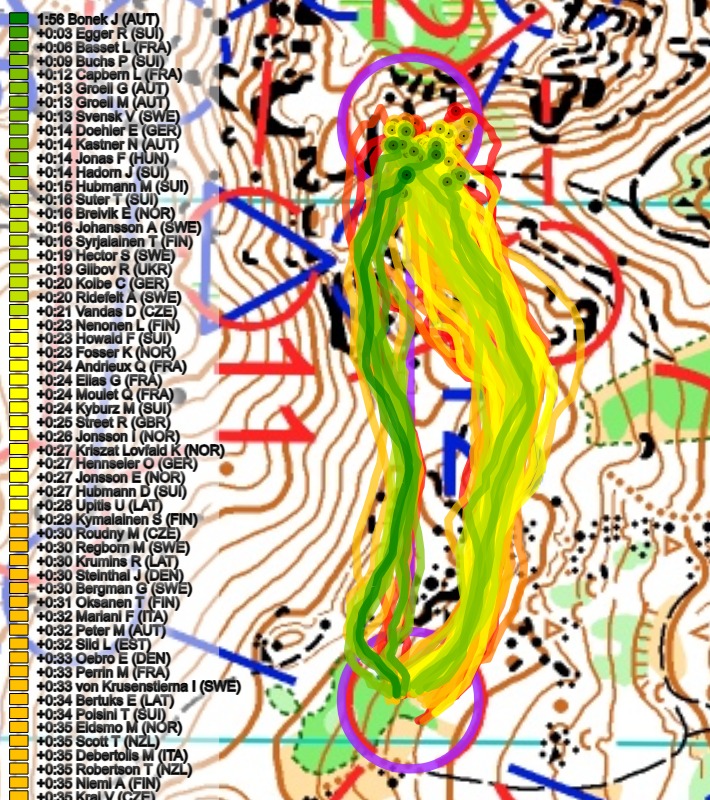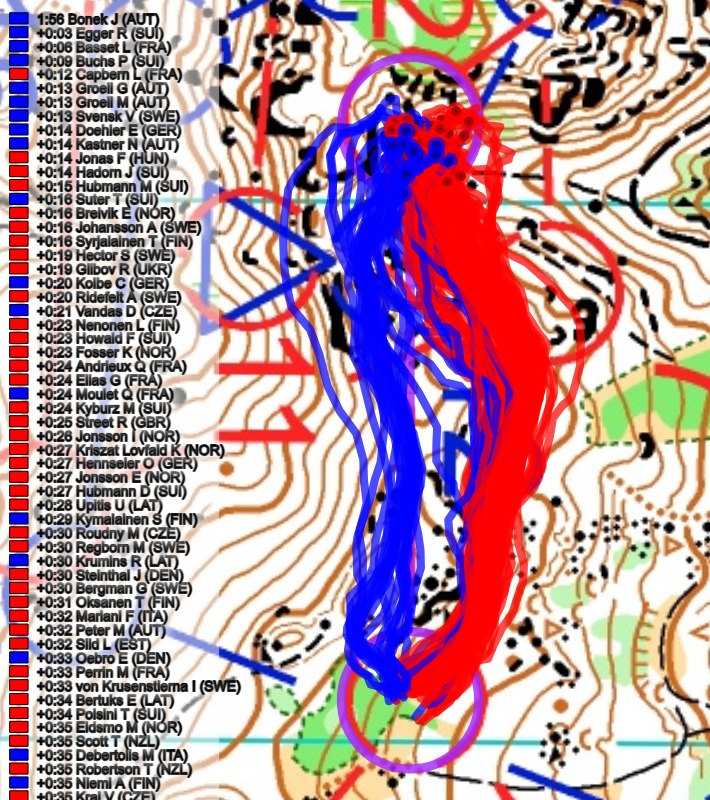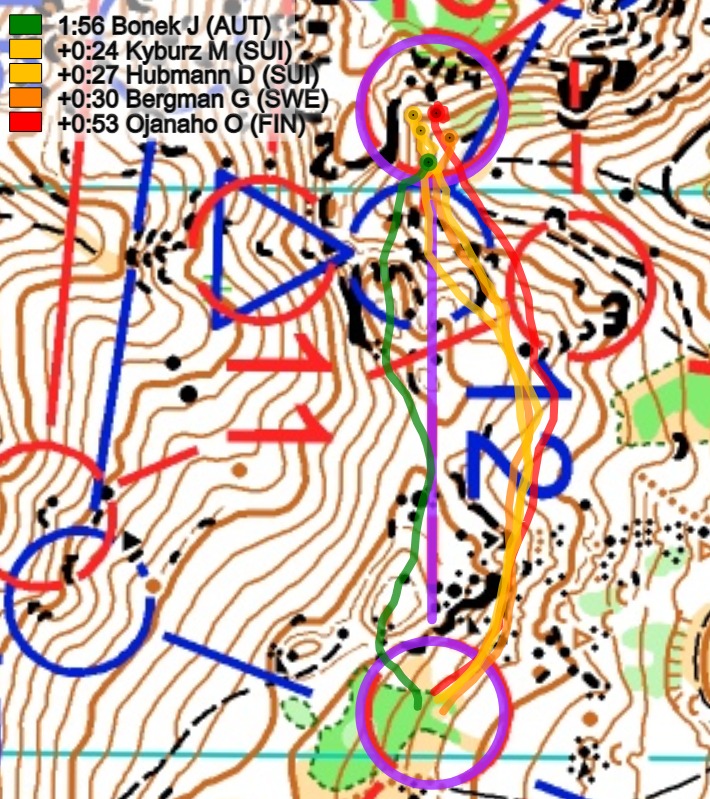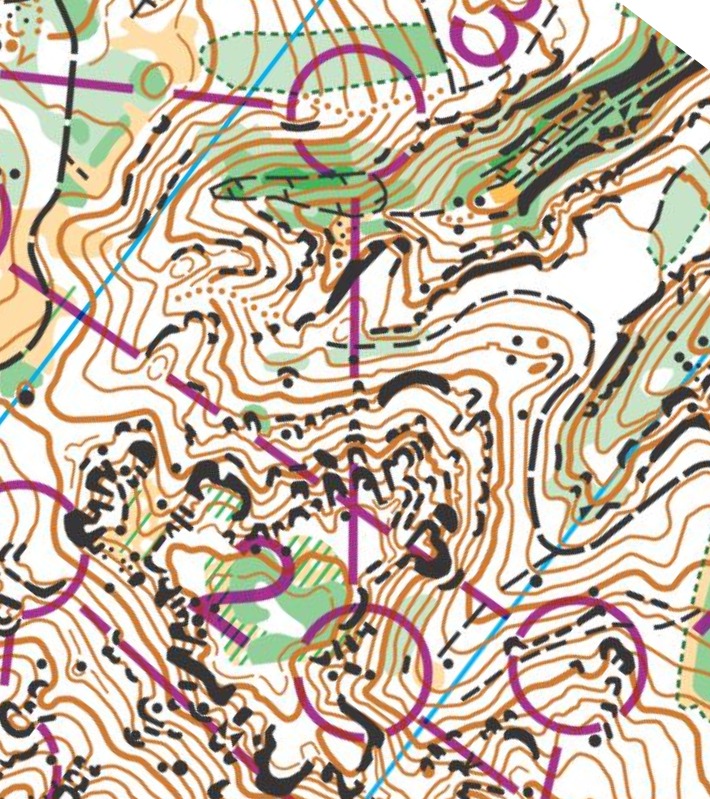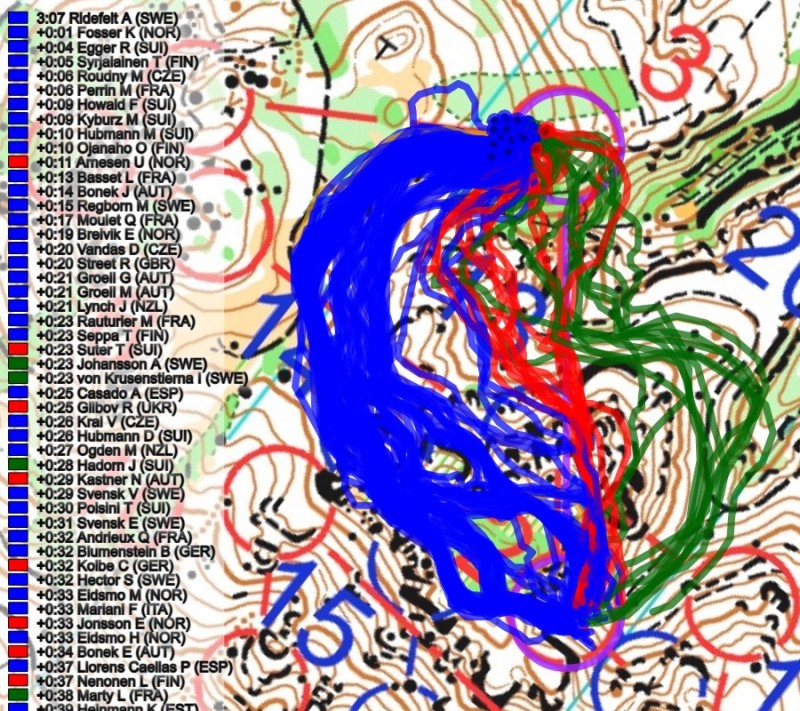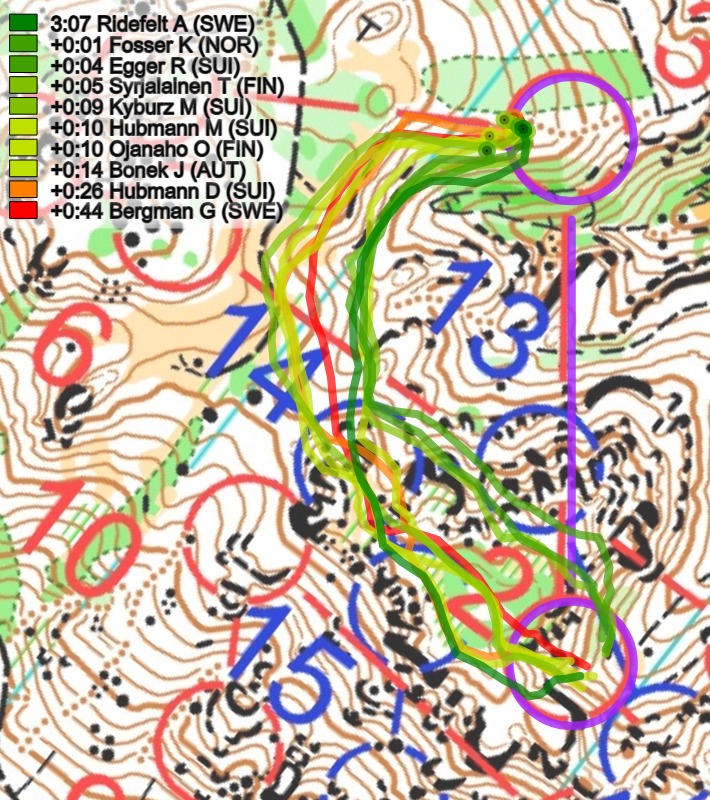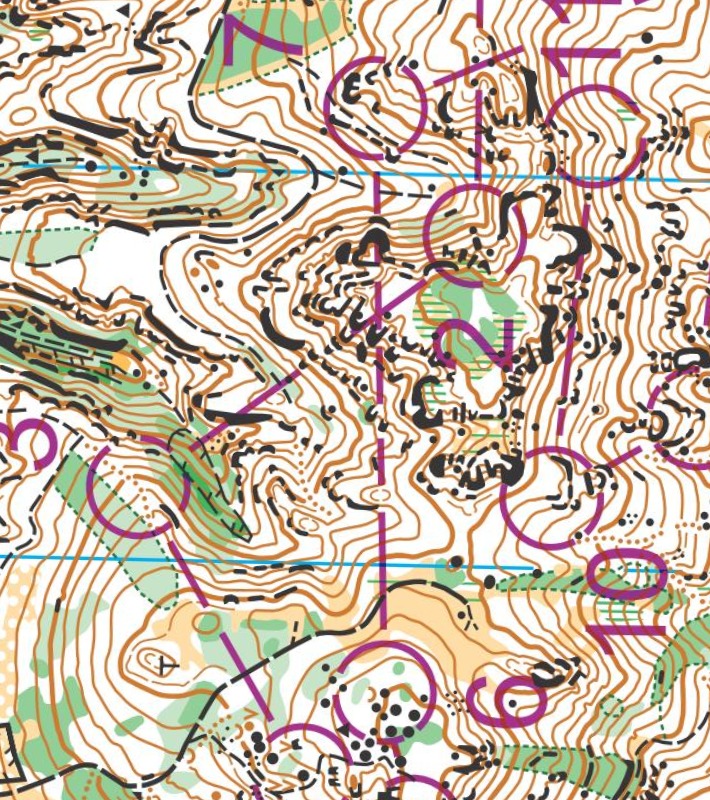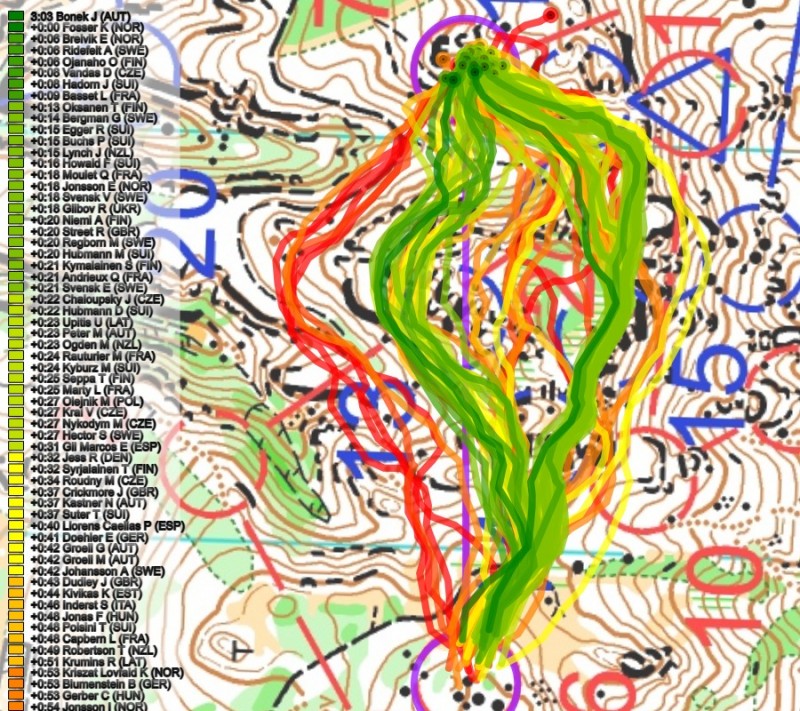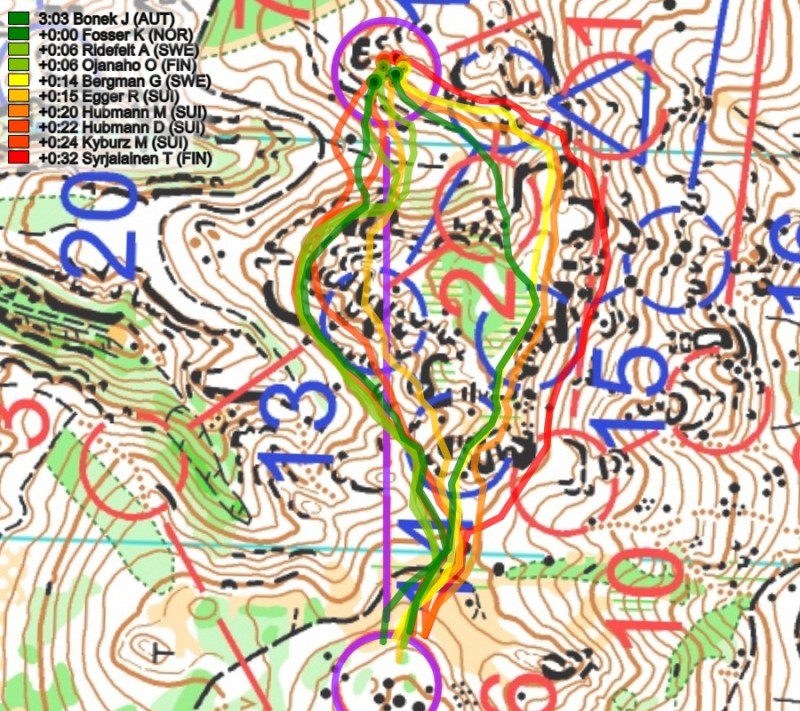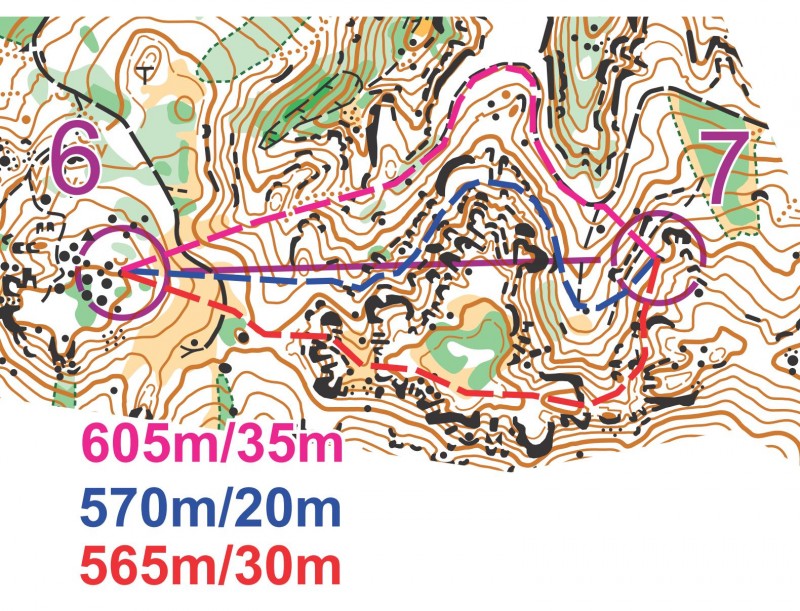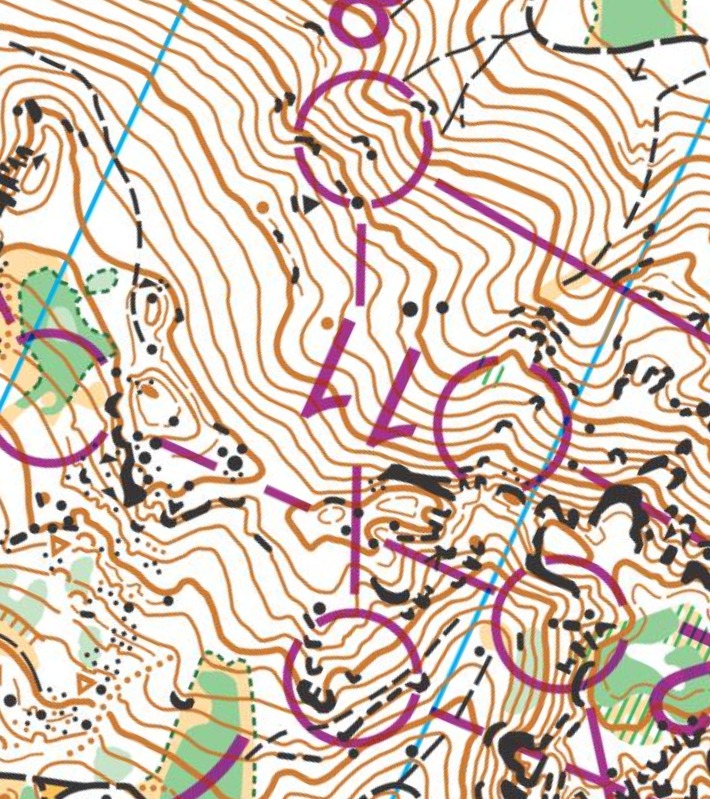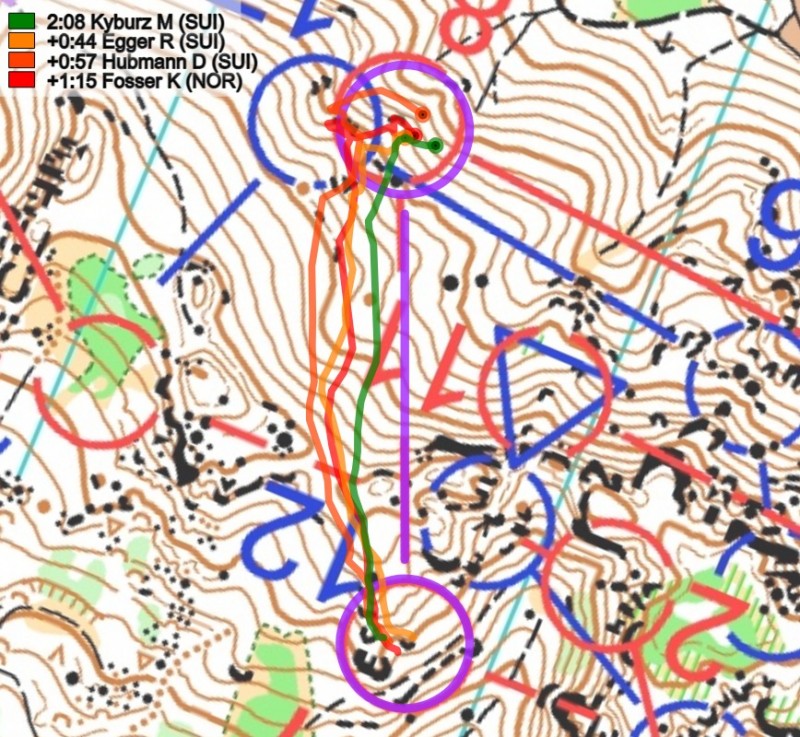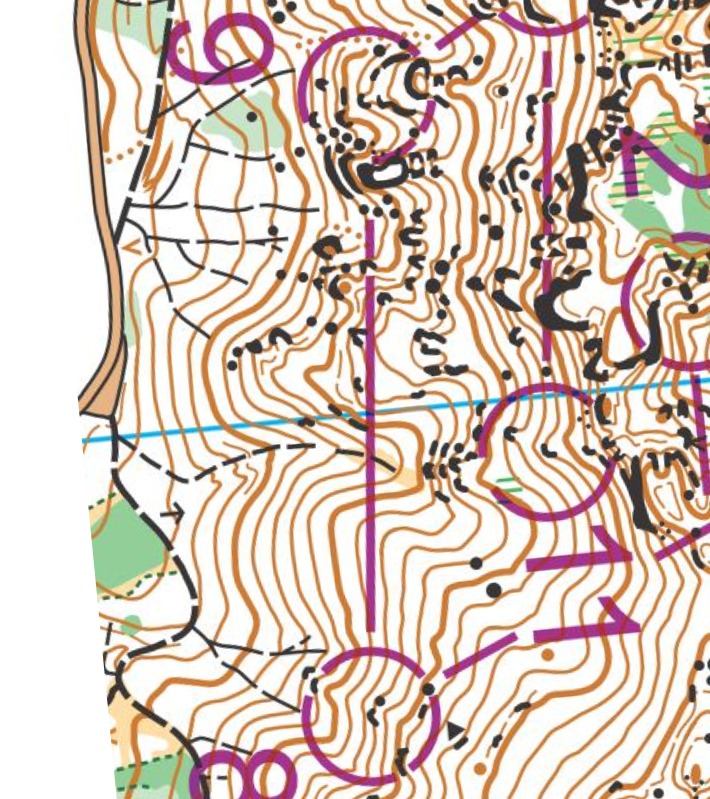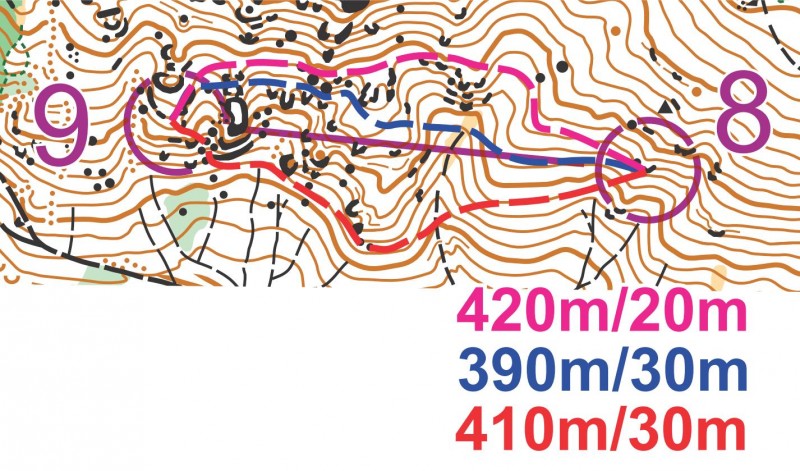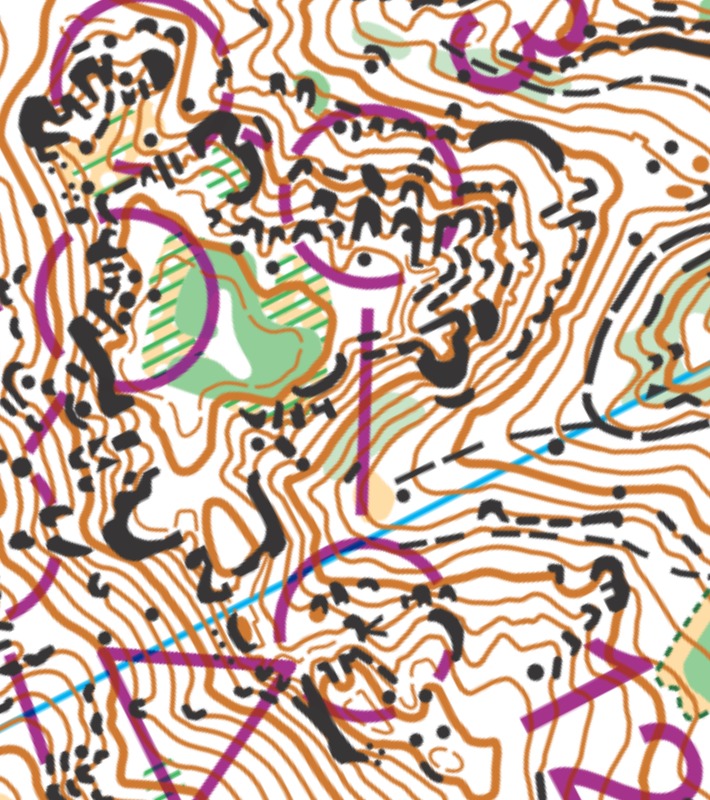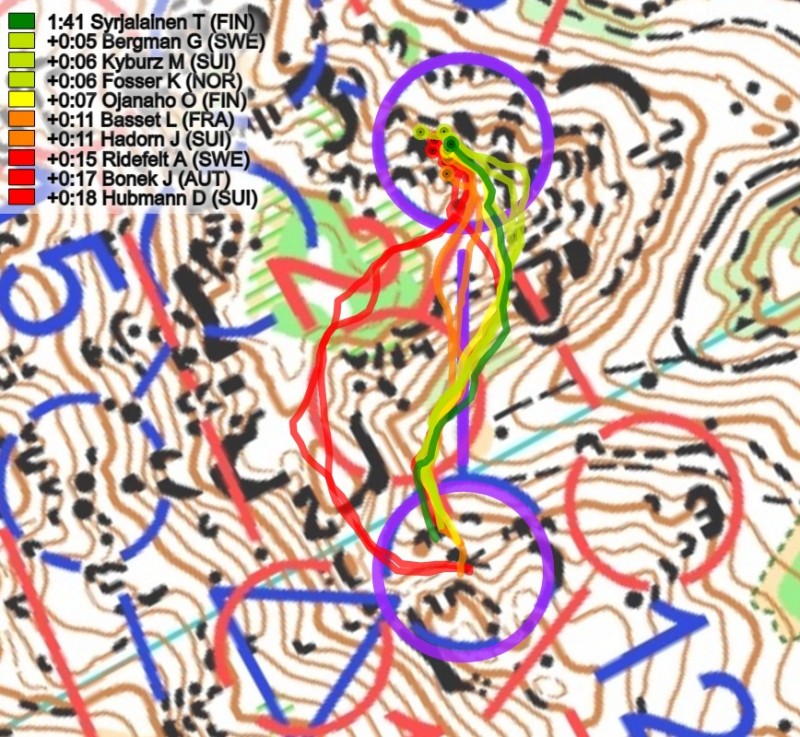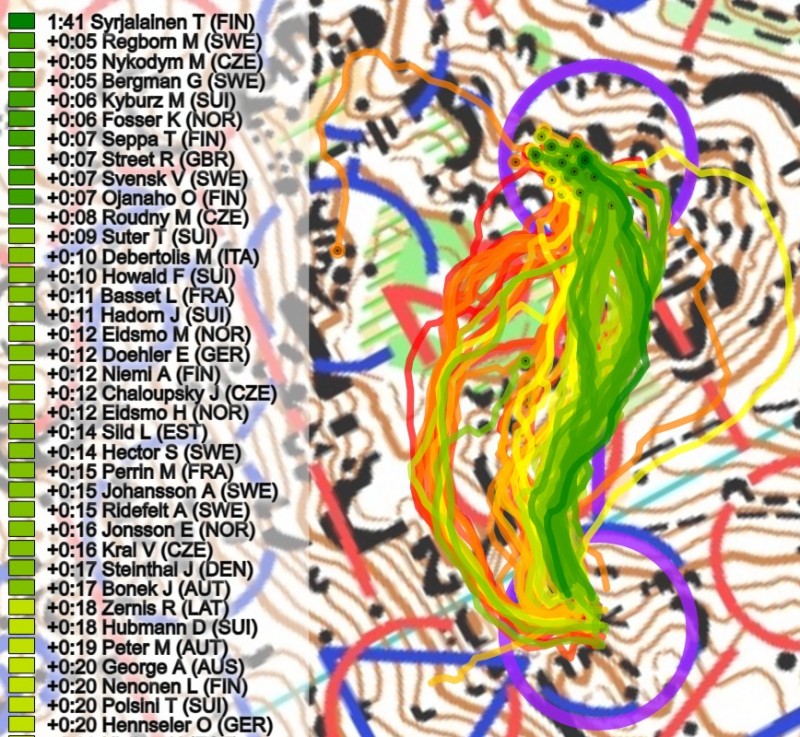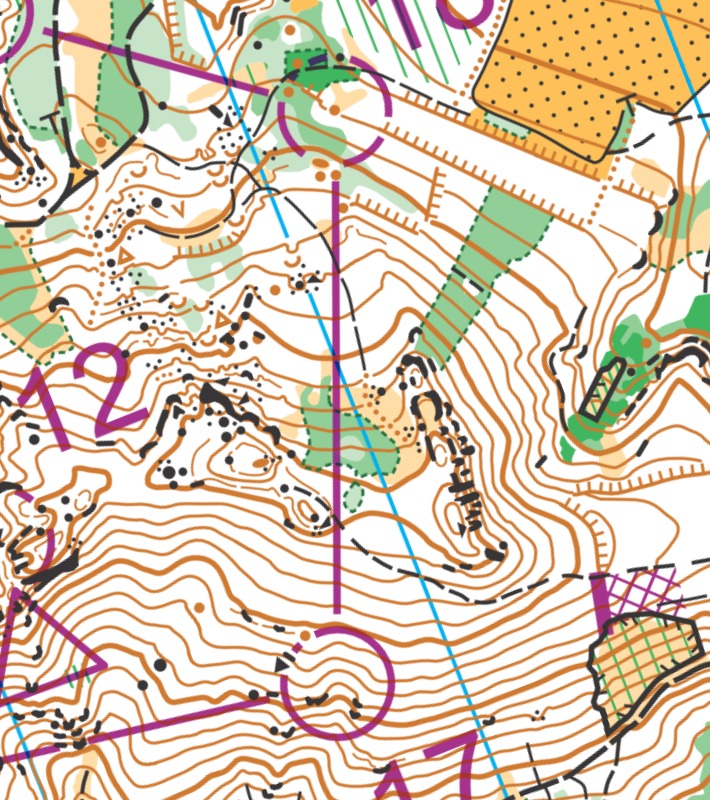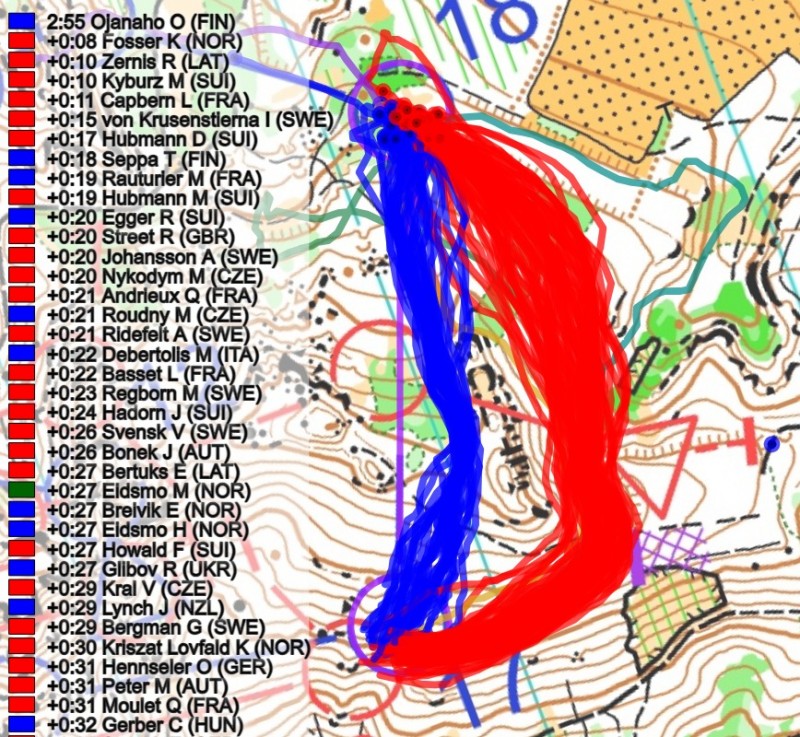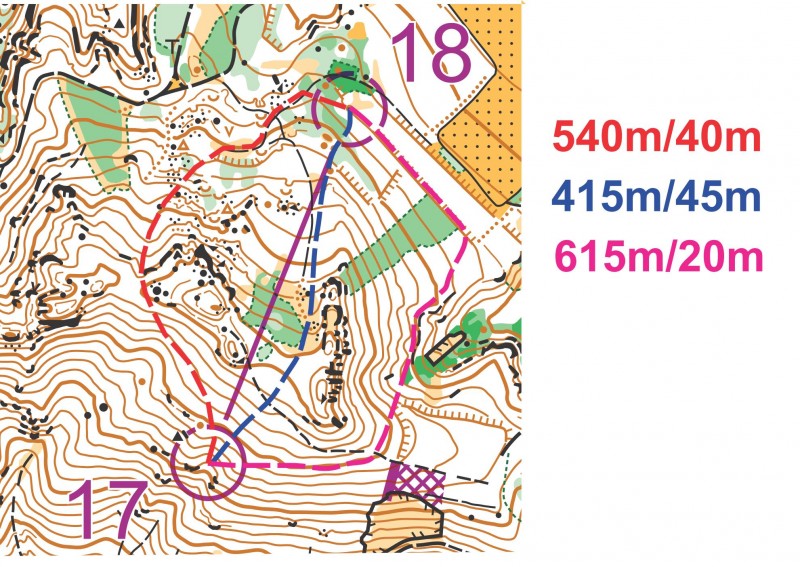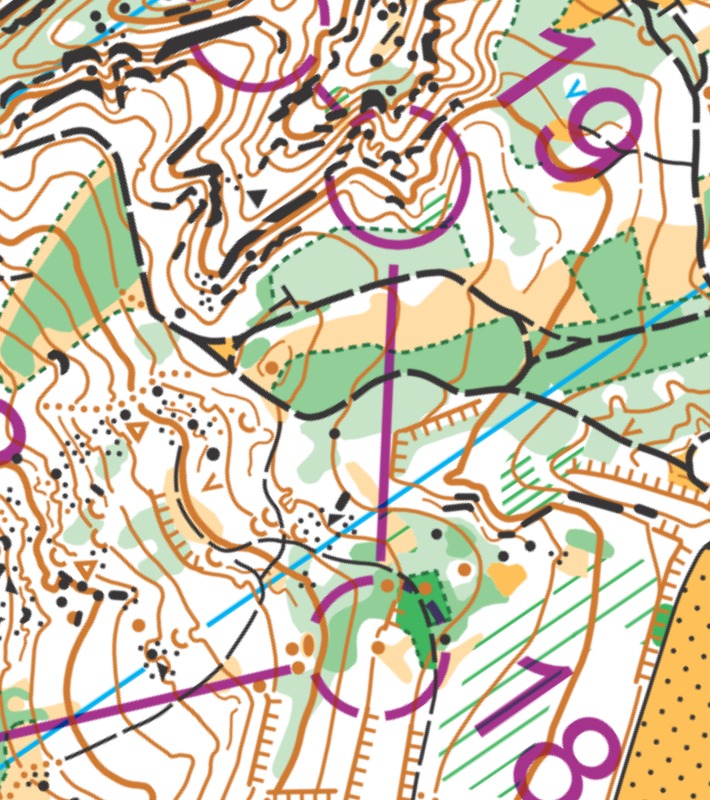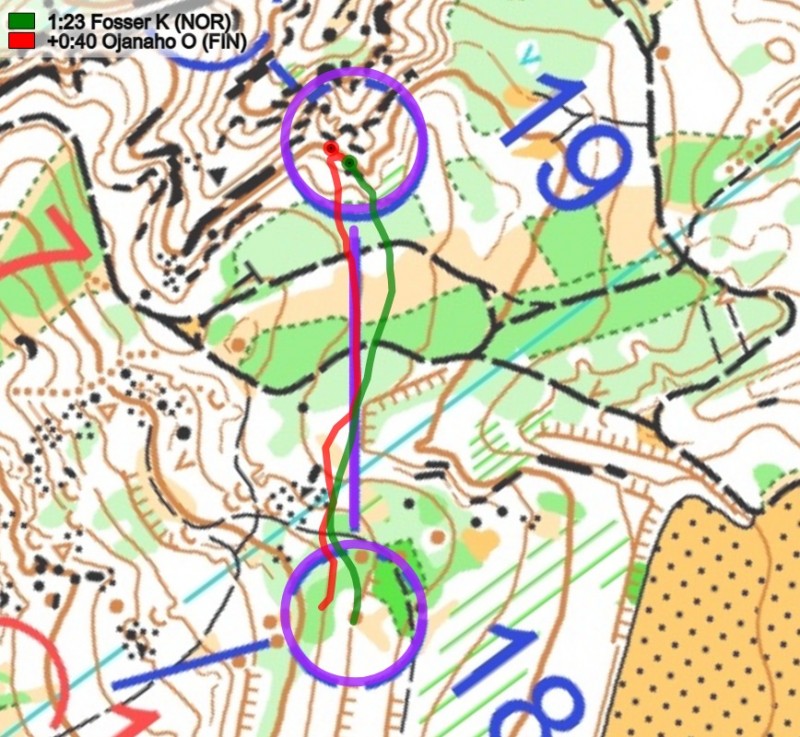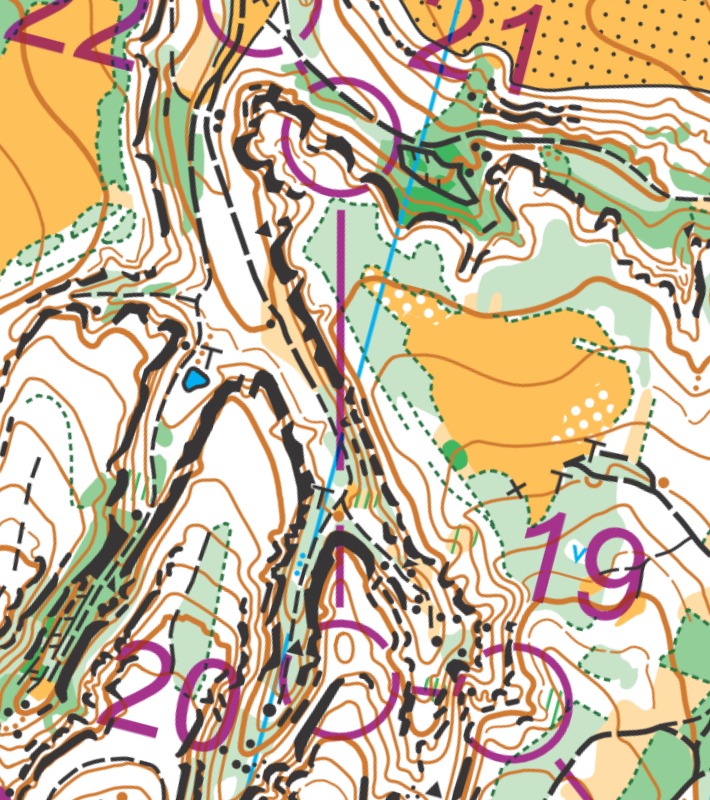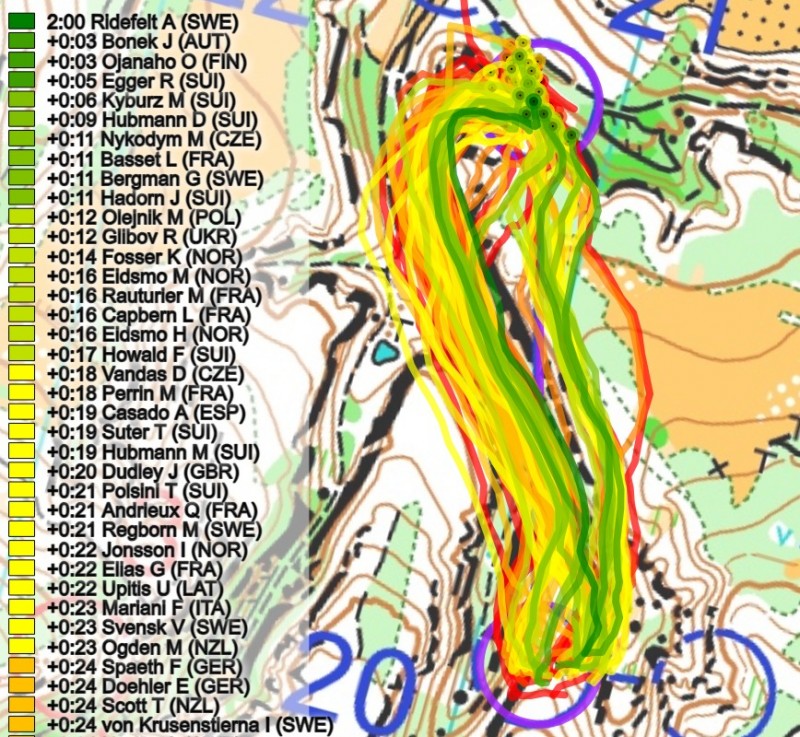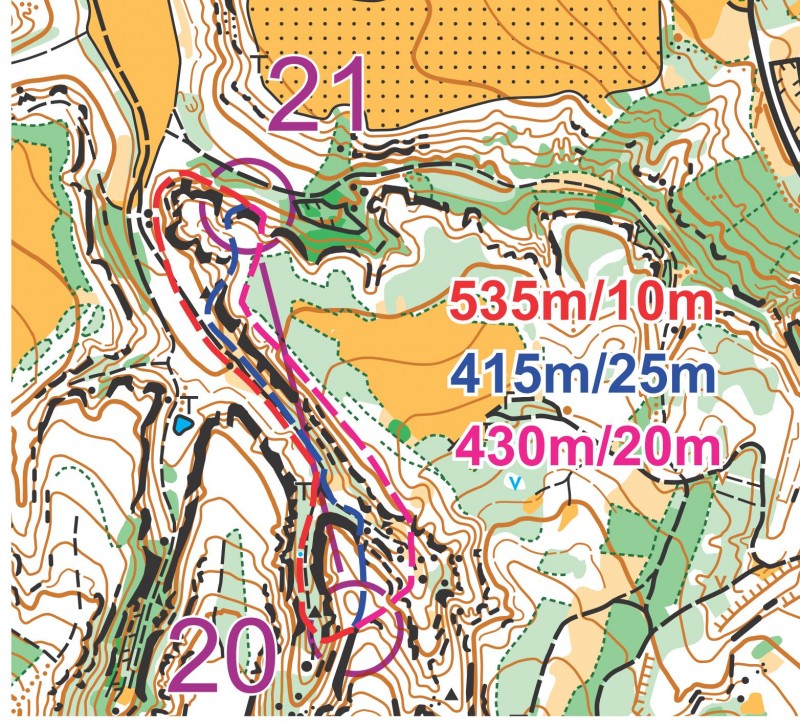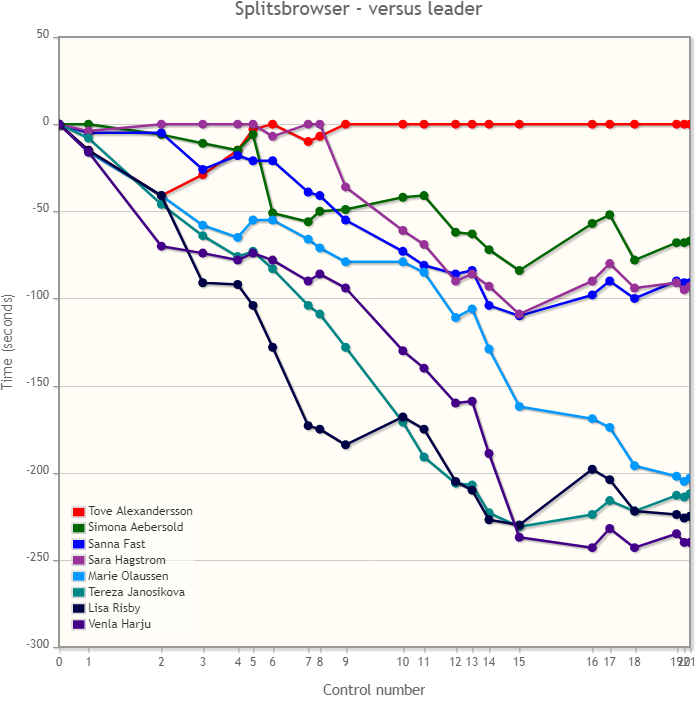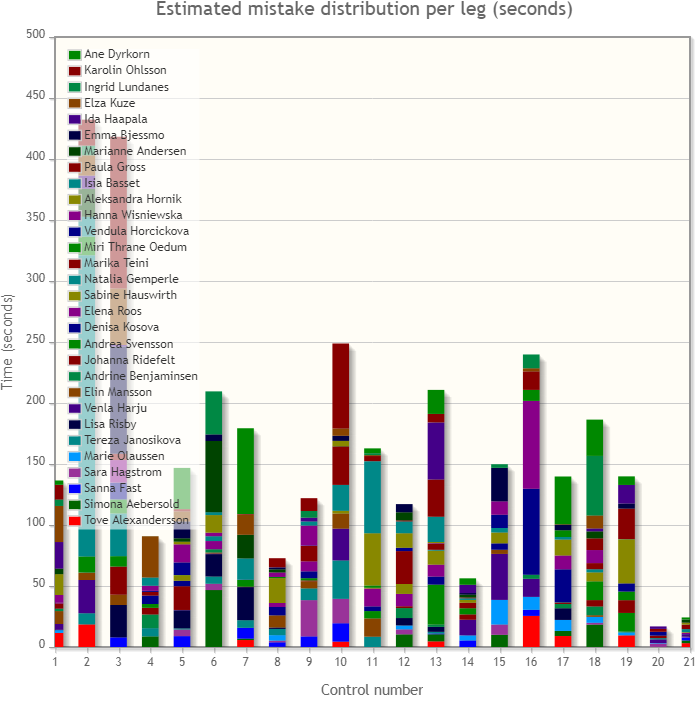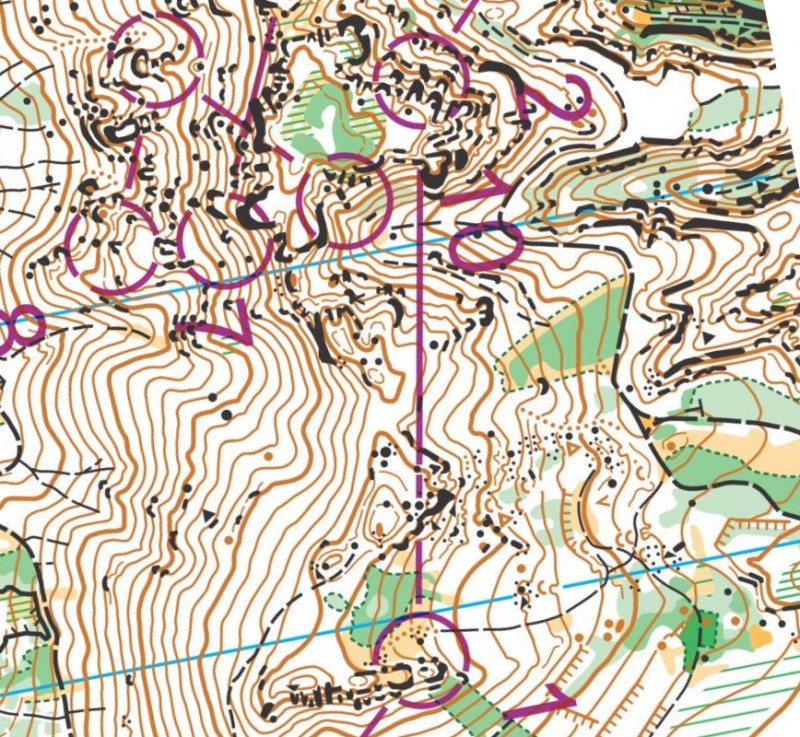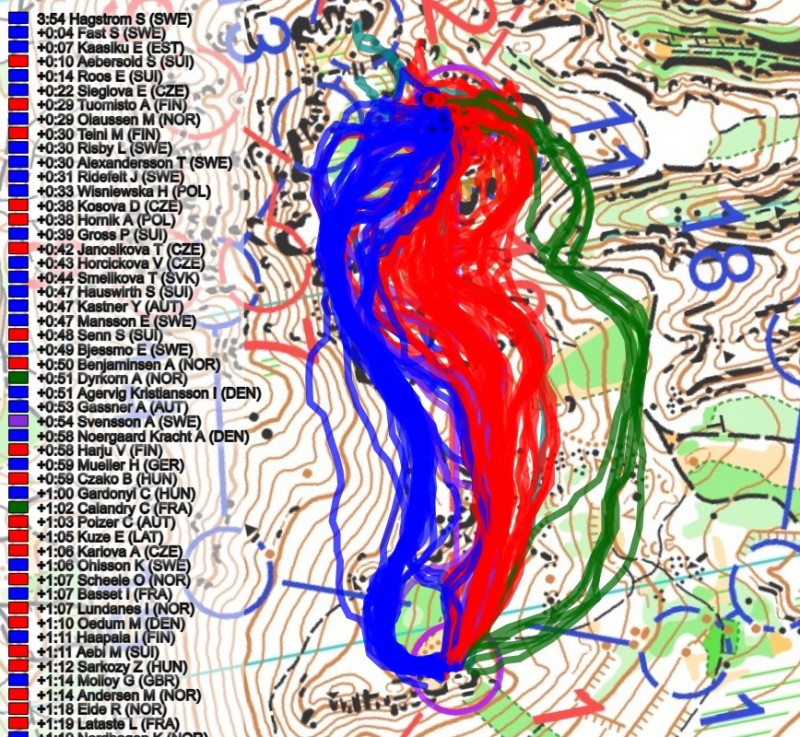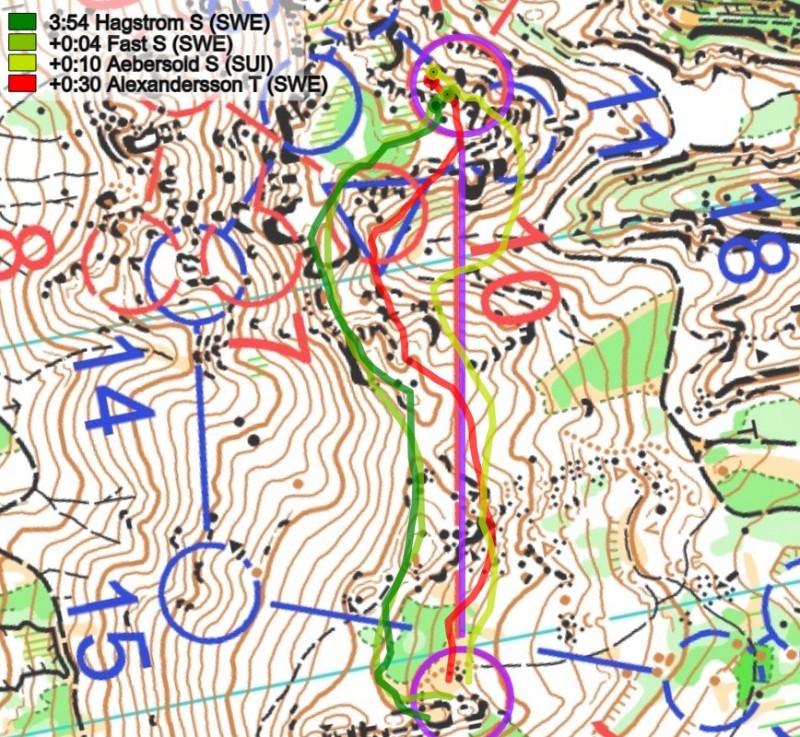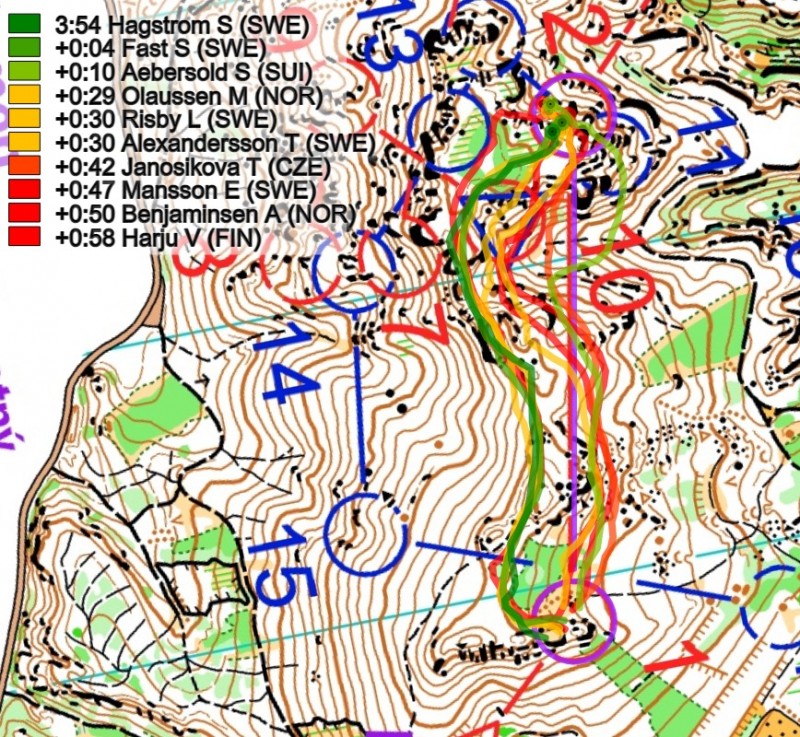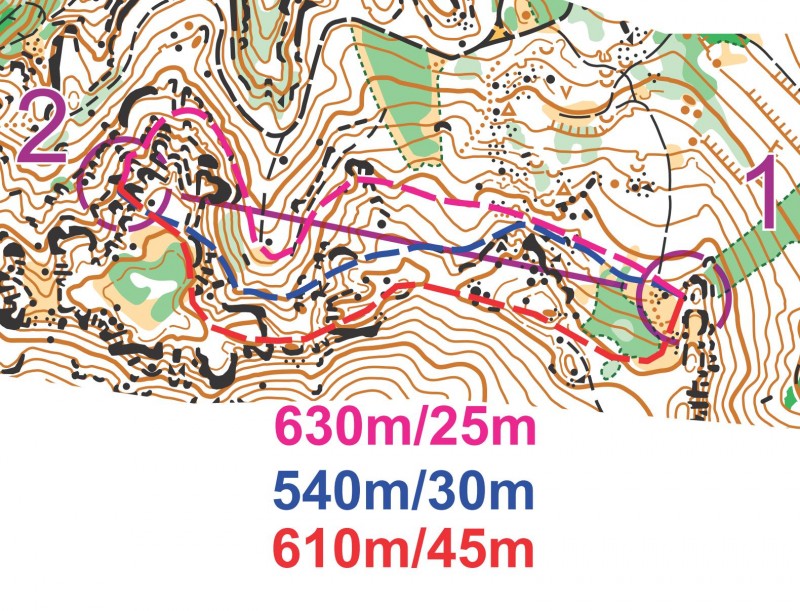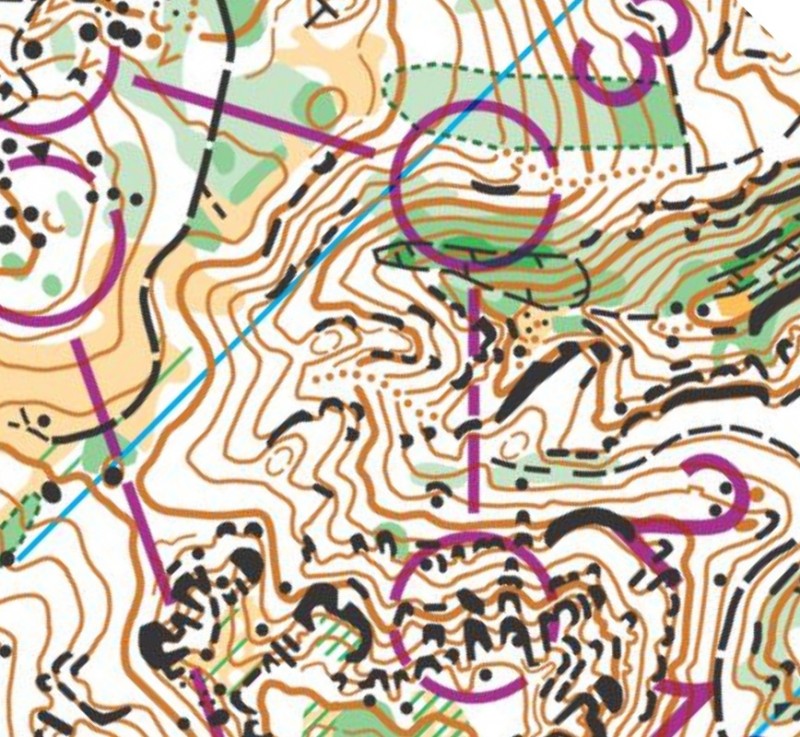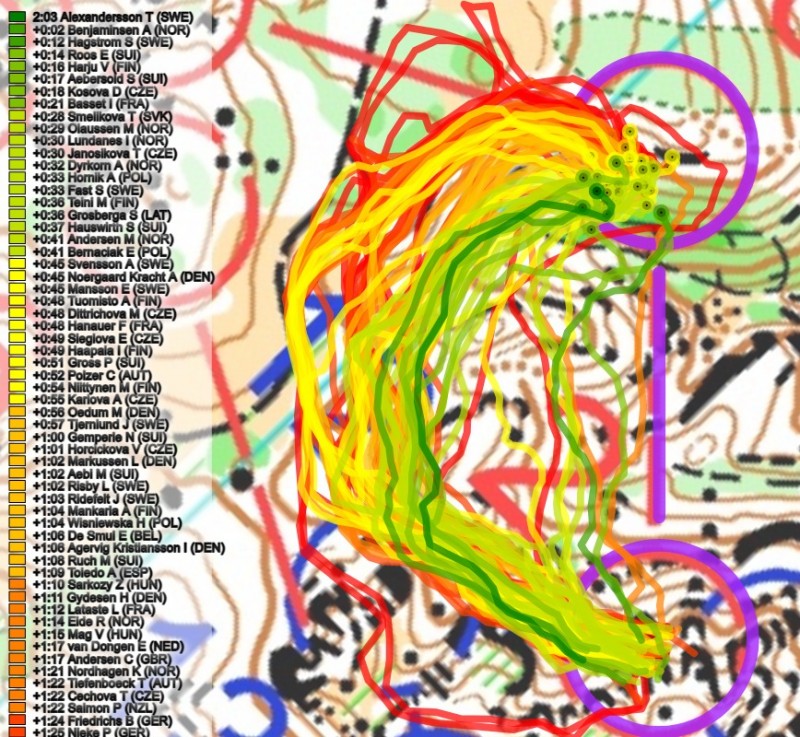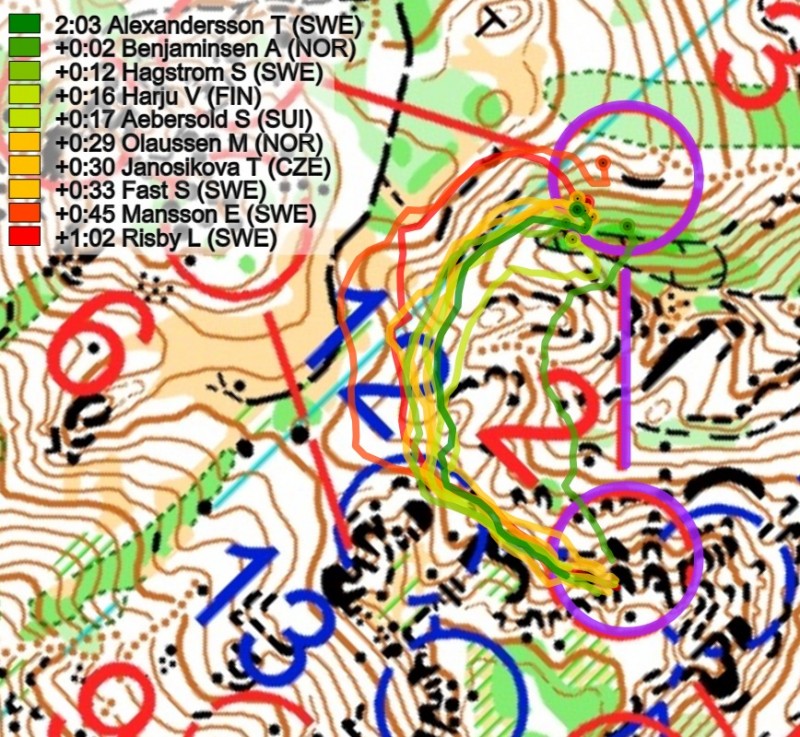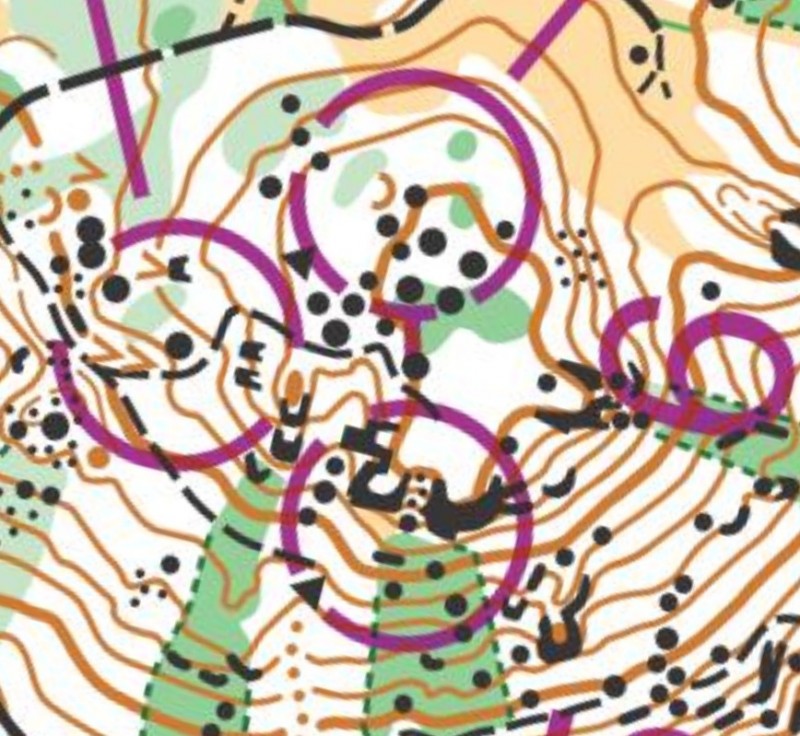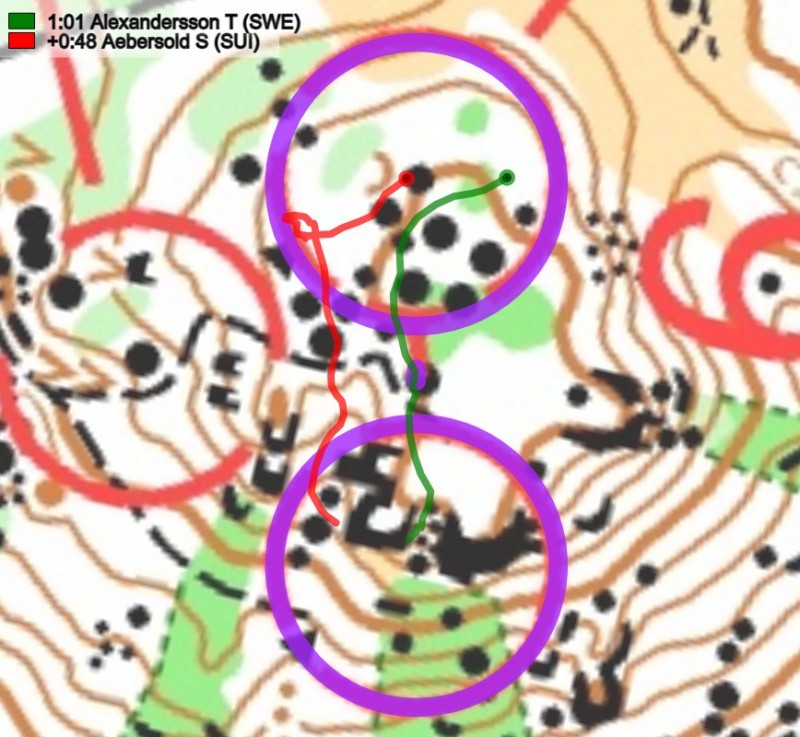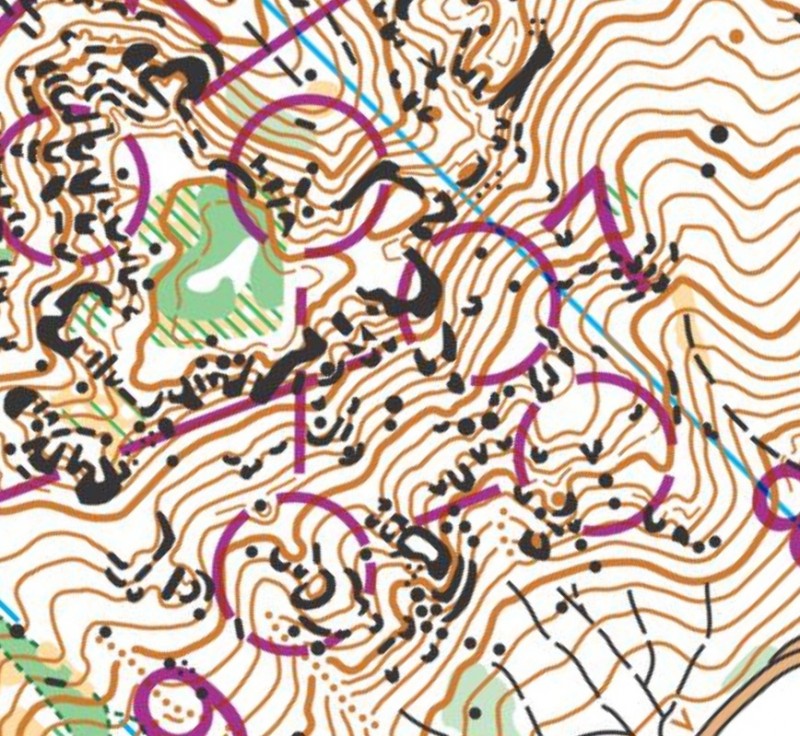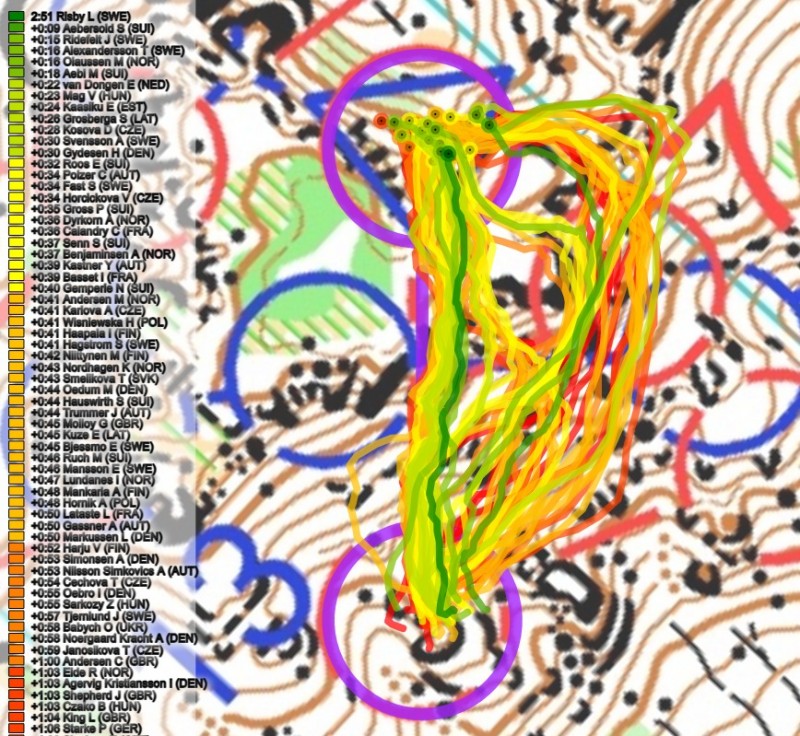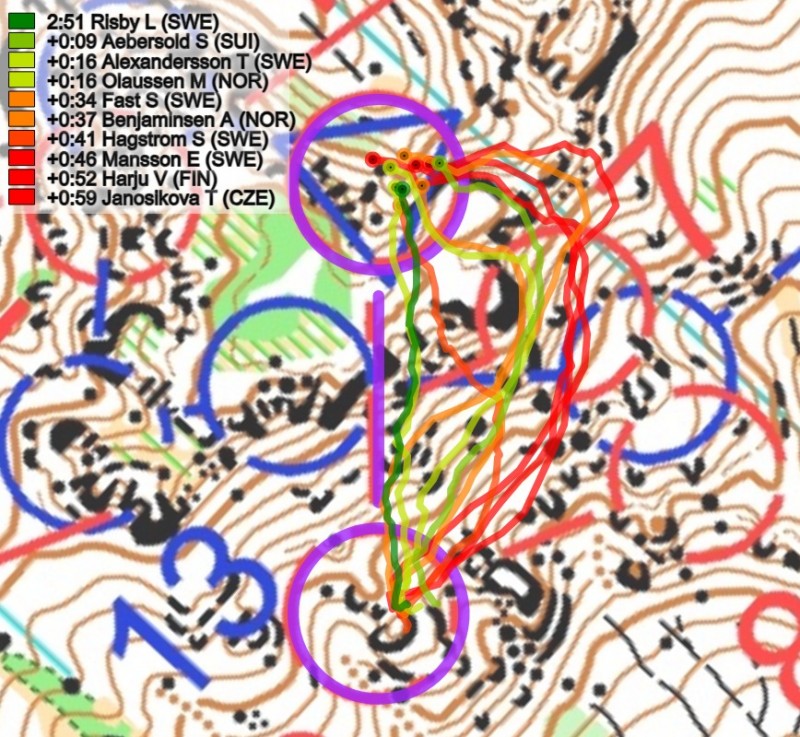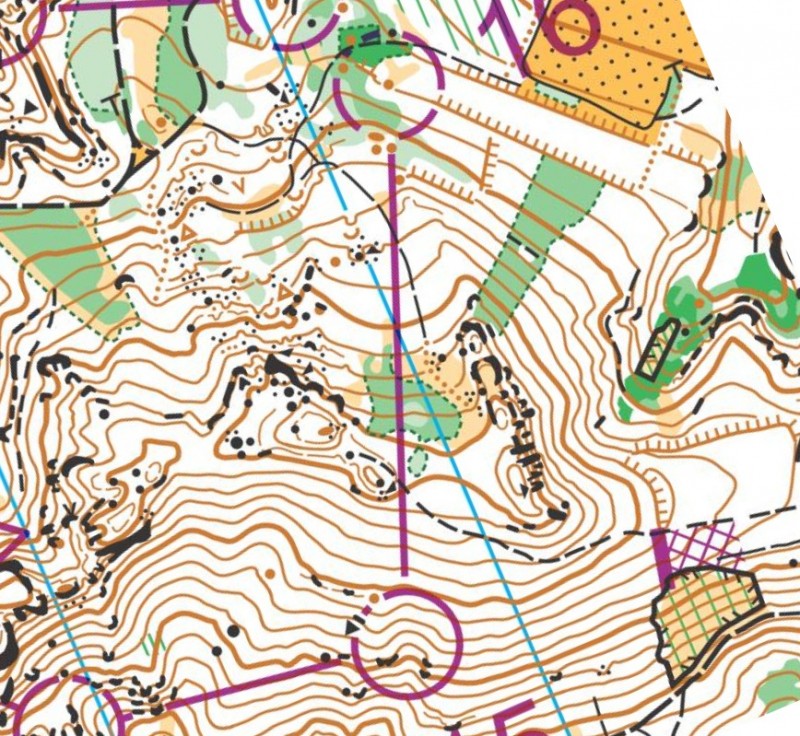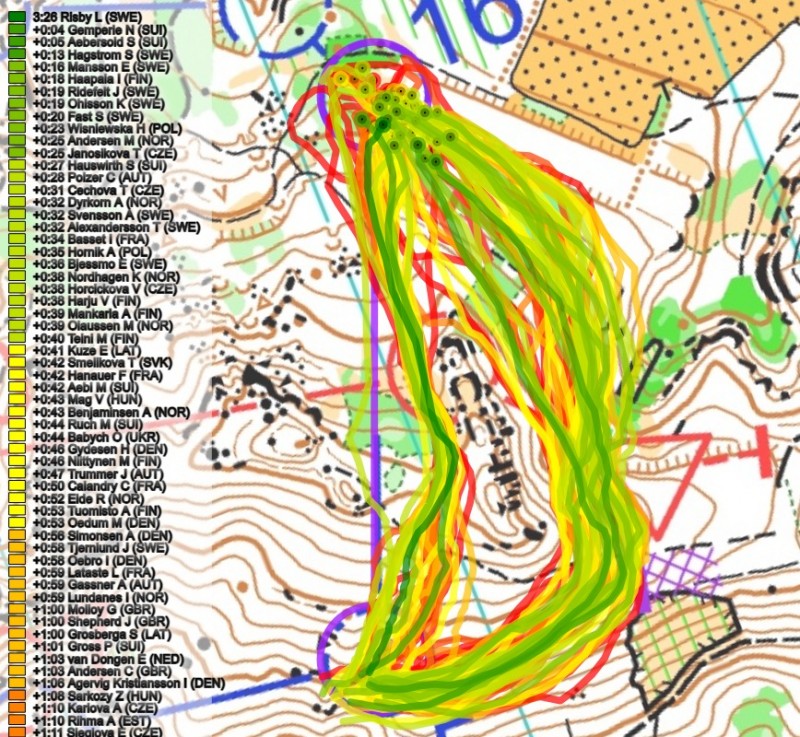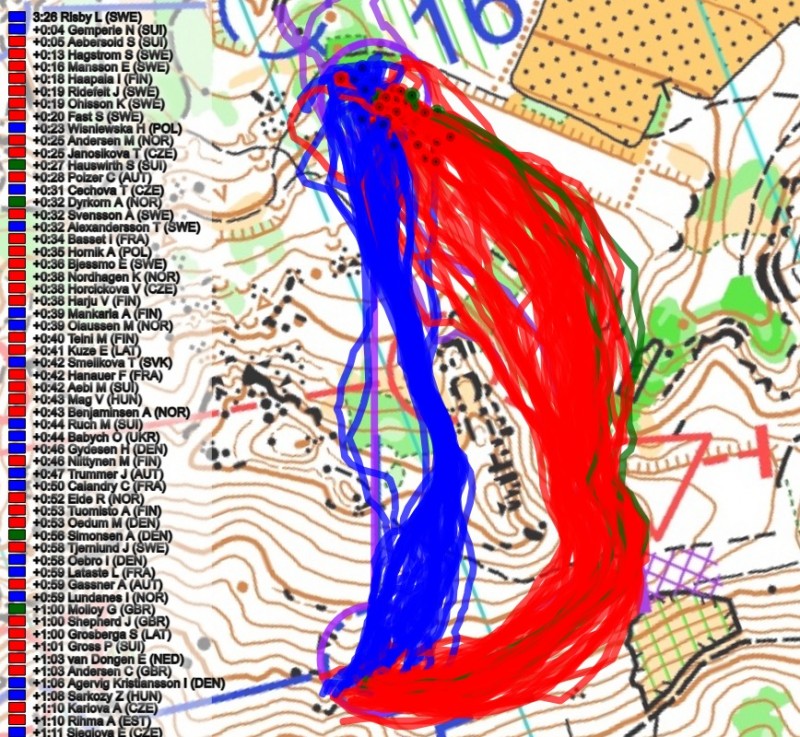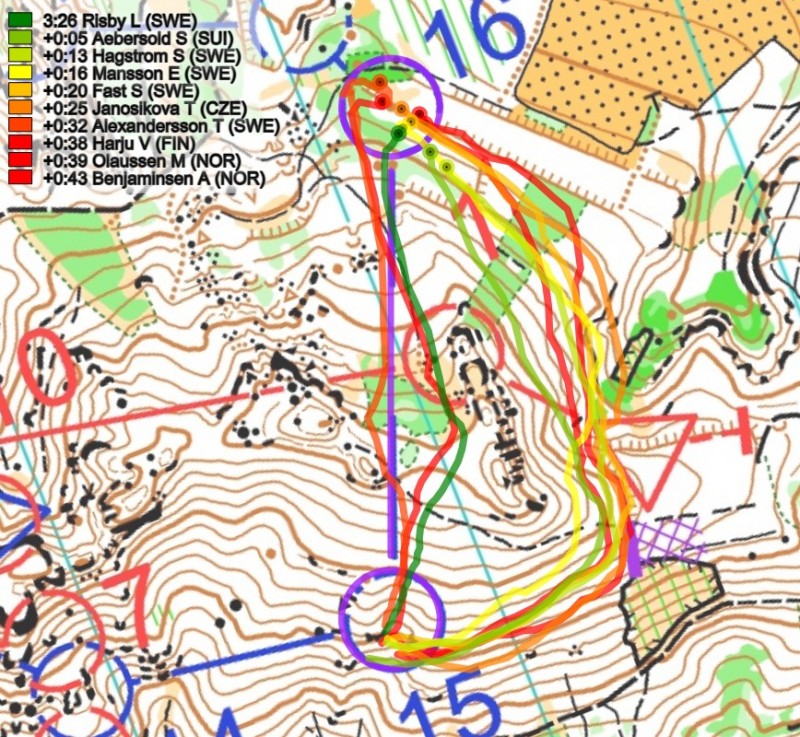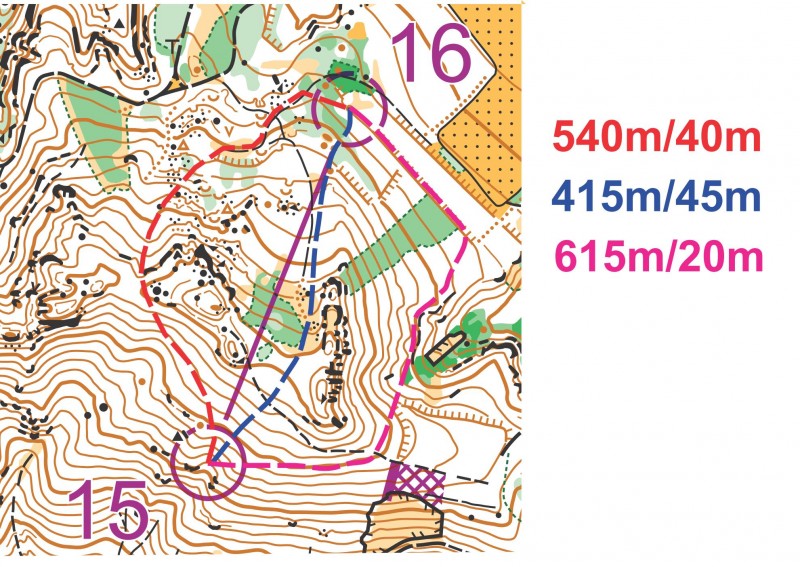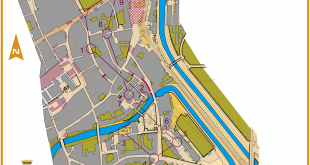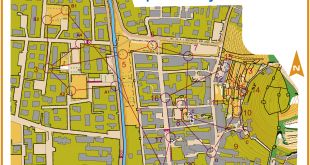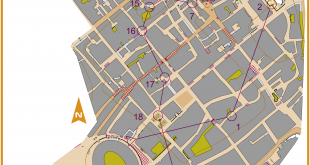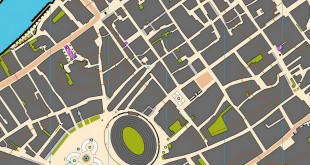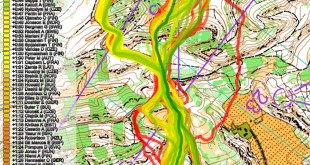The sandstone area in Korce, Czechia offered tricky orienteering in spectacular terrain! Read on to understand which controls were most challenging for the runners, how the best solved the challenges, and why Jannis Bonek (Austria) and Tove Alexandersson (Sweden) could finish the day on the top of the podium.
For maps, results and GPS-tracking, see the race report article “World Cup Czechia Middle: Maps and Results”. Read on to dig deeper into the courses.
Men
The below graphical split time illustration of the top runners (see here for only the top 6 runners) shows how Jannis Bonek decided the race by a combination of good speed and stable orienteering (except for a small timeloss to control 13 and 18). Several other runners had similar (or even higher) speed – but they did mistakes which cost them the podium position.
Based on this illustration, the quite long leg to control 8 without big routechoice challenges, but with a tricky control point in a slope, gave the biggest time losses among these runners (Fosser, Daniel Hubmann, Egger; Fosser lost more than he was behind in the end at this control alone). Also, the longer route choice legs to control 2 (Ojanaho, Bergman lost time), control 3 (Bergman, Daniel Hubmann), and control 7 (Kyburz, Syrjalainen) gave several runners trouble. In addition control 13 (Bonek, Syrjalainen; shorter routechoice leg), control 18 (Bonek, longer routechoice leg) and the short leg to control 19 (Ojanaho, Egger) were challenging for these runners. Below we take a closer look at these legs in addition to a few legs highlighted by the organizing team as interesting.
Control 2
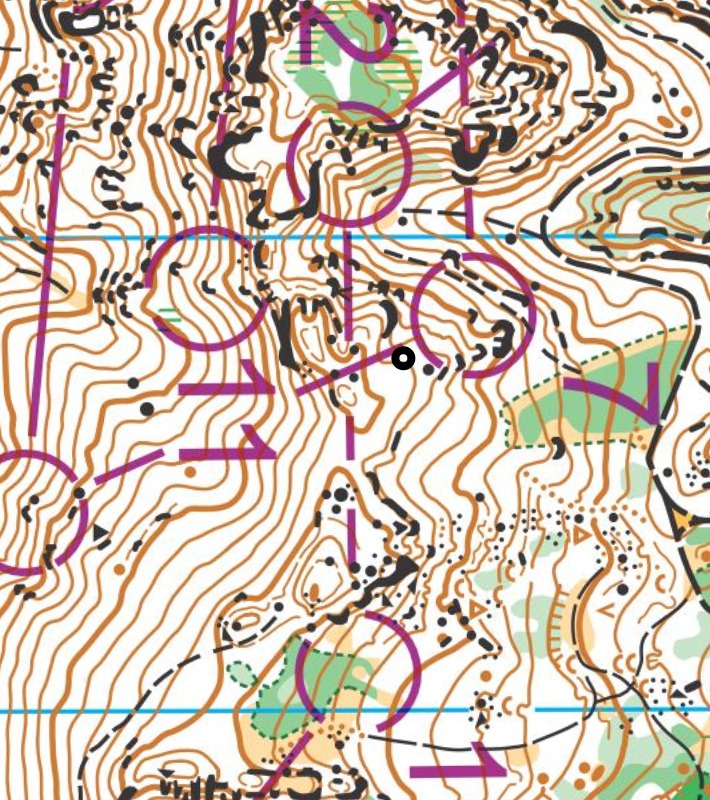
On this leg going up seems to be around 15-20 seconds faster, but it is possible to run quite well when keeping down in the slope if you find a good stroke (Capbern does this and loses only 12 seconds to the fastest split). You can run really fast on the top of the hill, and it is not far up to the top. Also, the orienteering is fairly easy on the top. Only Bonek, Egger and Basset of the top 11 finishers run up, and they are also the two fastest on the leg.
Control 3
Here it is quite clear that you should go around to the left, but how high in the slope should you run? All the top 10 ran to the left, but the rest of the field was “all over the place”. Based on the GPS and split times, you lose around 10-12 seconds if you run too far up in the slope (up towards the path to the left), but you could lose a lot of time if you went more direct or tried to round the hill far to the right (resulting in a tough climb to the control). Of the top 10, only Ridefelt, Fosser, Egger and Syrjalainen found the optimal routechoice in the slope to the left.
Control 7
Here it may seem quite tempting to run down to the path, and then take the climb back up to the control, but not many fell into that trap (but those who did really lost big time on it – this did cost around a minute or more). If you didn’t do this big mistake, execution of the leg meant more than routechoice, as it is quite tricky to navigate well in these slopes – and both right (Bonek won the leg right with perfect exection) and left (8 of the 10 best on the leg ran left) of the hill worked well. This was the control were Kyburz lost most time (24 seconds; but this was only half of what he was behind Bonek).
Here are route lengths and climb provided by the organizer.
Control 8
The route choice was not the big challenge here, but it is a tricky control, and several of the top runners came too far to the left and lost significant time here. Fosser lost 1:15 – that is more than he was behind in the end!
Control 9
There were no big time differences here, but this was one of the legs picked by the organizers as interesting where route lengths and climb was provided (see below). With rather modest differences in length and climb – and tricky orienteering in the slopes – execution proved to be more important than routechoice for this leg. The fastest times tended to be run by the ones going up (to the right) though, but with small time differences.
Control 13
A shorter routechoice leg which was one of the few legs where the winner Bonek took a wrong route. It may look like left should be a good alternative, but only 2 of the 40 fastest runners on this leg ran left, and that was Bonek and Daniel Hubmann who had been caught by Bonek at this point in the race, who lost 17-18 seconds to the fastest runner – an estimated timeloss of 10-12 seconds. A combination of longer route and slow running through the green is what leads to slower times on the left route.
Control 18
Running around to the right saves you 20 meter of climb, but you have to run 200 meter longer. In theory this should mean that straight is faster, but with more risky control taking straight – and maybe some tired legs – most of the top placed runners ran around to the right. Ojanaho again proved that he is exceptionally strong in the uphills at the end of races, winning the leg with 8 seconds by going straight, and being the only one of the Top 7 on the leg going straight. This is the leg where Bonek loses most time to the fastest split time (26 seconds to Ojanaho) by going around to the right, but it is difficult to see a specific reason for the timeloss based on the GPS (he is a bit lower than the others in the slope, though)
Control 19
Not a routechoice leg, but several runners do mistake into the control – notably Ojanaho loses the chance for taking a Top 3 here (pushing too hard towards the end of the race?). Very little movement is seen on the GPS, but still 40 seconds lost …
Control 21
The last control included is the 21st control – a routechoice leg which did not prove to be very decisive in the end.
Women
The below graphical split time illustration of the top runners (see here for only the top 4 runners) shows how Tove Alexandersson decided the race by having a speed that nobody could match – and missing only two controls (control 2 and 16). Behind Alexandersson, only Simona Aebersold, Sanna Fast and Sara Hagström (and partly Natalia Gemperle who missed a lot early in the race) had speed to fight for a Top 3. The bigger speed differences among the top women makes the analysis a bit more tricky.
The below illustration shows the controls were the Top 30 lost most time (estimated mistakes). Here one can see that the longer route choice leg to control 2 (where Gemperle lost 4:30) and the shorter route choice leg to control 3 where the most challenging for the women, with control 6 (short leg), control 10 (short routechoice leg) and control 16 (route choice leg similar to the 18th control in the men’s class; this is where Alexandersson lost time) also being problematic for some.
Control 2
The women had one of their trickiest legs already to the second control. It has some similarities to the second leg for the men, but is longer and it is a bit more difficult to run well in the slope. Running up to the left on the ridge gives fairly easy orienteering and is probably the safest choice here (5 of the 6 fastest on the leg take this choice), although you have to cross a green area towards the control – it was probably an advantage to start late here. Going all the way down is clearly too slow. Going more straight can go well (Aebersold did this with some success, losing 10 seconds to the fastest split; the GPS is probably a bit off so she rounded more than it may look like), while Alexandersson lost 30 seconds by running quite high in the slope – one of her worst legs. Many, many runners lost time due to bad execution here, especially when running in the upper part of the slope.
Control 3
This leg has some similarities with the men’s 3rd leg, but is shorter (one valley shorter). The key here was to run around in the slope to the left – but not too high up as that is both longer and gives more climb. Benjaminsen somehow manages to run a good time nearly straight.
Control 6
A short leg to the TV-control gave extra pressure – too much pressure for Aebersold seemingly. Note that Aebersold’s GPS is a bit off here, but the split time is from the official split times so the 48 seconds lost are correct.
Control 10
Control 10 was tricky for many of the women. The safest strategy here is to go straight – but when you have tired legs and you see a long, steep uphill in front of you, it is tempting to try to save some climb. Here that is costly, though, as there is realistically not many meters of climb you can save (if you look carefully at the map), and you have to run the extra meters in a steep slope. 6 of the top 10 lost more than 30 seconds to the fastest split time here.
Control 16
This leg is similar to the 18th leg for the men, and as for the men the fastest time is run straight. But note that while three of the Top 10 finishers run straight, two of them lose more than 30 seconds due to mistake at the control – this control is quite tricky from above (Tove Alexandersson and Marie Olassen – this is Alexandersson’s worst leg). Several also lose time by running right, clearly exection is not easy there either, although the control taking is easier.
 World of O News
World of O News
